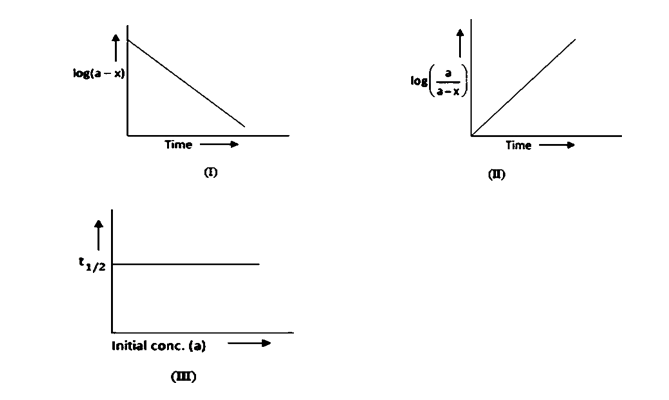Consider the following statement :
1 The rate of reaction is always proportinal to the concentration of reactants.
2 The order of an elementary chemical reaction step can be determined by examing its stoichimoetry.
3 The first order reactions follows an exponential time course.
Of these statements :
1, 2 and 3 are correct
1 and 2 are correct
2 and 3 are correct
1 and 3 are correct
The correct Answer is:C
To analyze the given statements regarding chemical kinetics, we will evaluate each statement one by one.
Step 1: Evaluate Statement 1
Statement: The rate of reaction is always proportional to the concentration of reactants.
Analysis: This statement is incorrect. In the case of zero-order reactions, the rate of reaction is constant and does not depend on the concentration of reactants. For example, in a zero-order reaction, the rate can be expressed as:
Rate=k
where k is the rate constant. Thus, the rate is not proportional to the concentration of reactants.
Step 2: Evaluate Statement 2
Statement: The order of an elementary chemical reaction step can be determined by examining its stoichiometry.
Analysis: This statement is correct. For elementary reactions, the rate law can be directly derived from the stoichiometry of the reaction. For instance, if we consider an elementary reaction:
2A+B→C
The rate law can be expressed as:
Rate=k(A)2(B)1
Here, the order of the reaction with respect to A is 2, and with respect to B is 1, which corresponds to their stoichiometric coefficients.
Step 3: Evaluate Statement 3
Statement: The first-order reactions follow an exponential time course.
Analysis: This statement is correct. For first-order reactions, the concentration of the reactant decreases exponentially over time. The relationship can be expressed as:
(A)=(A0)e−kt
where (A) is the concentration at time t, (A0) is the initial concentration, k is the rate constant, and t is time. This shows that the concentration decreases exponentially with time.
Conclusion
Based on the evaluations:
- Statement 1 is incorrect.
- Statement 2 is correct.
- Statement 3 is correct.
Thus, the correct answer is that statements 2 and 3 are true.
Statement: The rate of reaction is always proportional to the concentration of reactants.
Rate=k
where k is the rate constant. Thus, the rate is not proportional to the concentration of reactants.
Statement: The order of an elementary chemical reaction step can be determined by examining its stoichiometry.
2A+B→C
The rate law can be expressed as:
Rate=k(A)2(B)1
Here, the order of the reaction with respect to A is 2, and with respect to B is 1, which corresponds to their stoichiometric coefficients.
Statement: The first-order reactions follow an exponential time course.
(A)=(A0)e−kt
where (A) is the concentration at time t, (A0) is the initial concentration, k is the rate constant, and t is time. This shows that the concentration decreases exponentially with time.
Based on the evaluations:
- Statement 1 is incorrect.
- Statement 2 is correct.
- Statement 3 is correct.
Topper's Solved these Questions
- BOOK - VMC MODULES ENGLISHCHAPTER - CHEMICAL KINETICS EXERCISE - Level-2 ( Numerical Value Type for JEE Main )15videos
CHEMICAL KINETICS
- BOOK - VMC MODULES ENGLISHCHAPTER - CHEMICAL KINETICS EXERCISE - JEE Main (Archive)56videos
CHEMICAL KINETICS
- BOOK - VMC MODULES ENGLISHCHAPTER - CHEMICAL KINETICS EXERCISE - Level-175videos
CHEMICAL KINETICS
- BOOK - VMC MODULES ENGLISHCHAPTER - CHEMICAL EQUILIBRIUMEXERCISE - IN-CHAPTER EXERCISE - G10videos
CHEMICAL EQUILIBRIUM
- BOOK - VMC MODULES ENGLISHCHAPTER - CHEMICAL THERMODYNAMICS EXERCISE - IN - CHAPTER EXERCISE - L10videos
CHEMICAL THERMODYNAMICS
Similar Questions
The rate constant of a first order reaction is proportional to the concentration of the reactant.
View SolutionThe rate constant of a first order reaction is proportional to the concentration of the reactant.
View SolutionThe rate constant of a first order reaction is proportional to the concentration of the reactant.
View SolutionIn a reaction A→B the rate of reaction increases two times on increasing the concentration of the reactant four times, then order of reaction is
View SolutionA : Rate of reaction depends upon the concentration of the reactants.
R : The order of reaction can be negative with respect to substance present in the reaction.View SolutionIf the concentration of the reactants is increased, the rate of reaction for first order-
View SolutionFor a first order reaction, the rate of the reaction doubled as the concentration of the reactant is doubled.
View SolutionWhich of the following expression is correct for first order reaction? Ao refers to initial concentration of reactant
View SolutionWhich of the following is/are correct for the first order reaction ? (a is initial concentration of reactant, x is concentration of the reactant reacted and t is time)
 View Solution
View SolutionThe rate of first-order reaction is 1.5×10−2Mmin−1 at 0.5M concentration of reactant. The half-life of reaction is
View Solution

